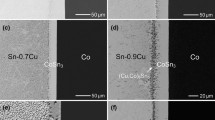Abstract
The reaction between the Sn-Ag-Cu solders and Ni at 250°C for 10 min and 25 h was studied. Nine different Sn-Ag-Cu solders, with the Ag concentration fixed at 3.9 wt.% and Cu concentrations varied between 0.0–3.0 wt.%, were used. When the reaction time was 10 min, the reactions strongly depended on the Cu concentration. At low-Cu concentrations (≦0.2 wt.%), only a continuous (Ni1−xCux)3Sn4 layer formed at the interface. When the Cu concentration increased to 0.4 wt.%, a continuous (Ni1−xCux)3Sn4 layer and a small amount of discontinuous (Cu1−yNiy)6Sn5 particles formed at the interface. When the Cu concentration increased to 0.5 wt.%, the amount of (Cu1−yNiy)6Sn5 increased and (Cu1−yNi6)6Sn5 became a continuous layer. Beneath this (Cu1−yNiy)6Sn5 layer was a very thin but continuous layer of (Ni1−xCux)3Sn4. At higher Cu concentrations (0.6–3.0 wt.%), (Ni1−xCux)3Sn4 disappeared, and only (Cu1−yNiy)6Sn5 was present. The reactions at 25 h also depended strongly on the Cu concentration, proving that the strong concentration dependence was not a transient phenomenon limited to a short reaction time. The findings of this study were rationalized using the Cu-Ni-Sn isotherm. This study shows that precise control over the Cu concentration in solders is needed to produce consistent results.
Similar content being viewed by others
References
K.-W. Moon, W.J. Boettinger, U.R. Kattner, F.S. Biancaniello, and C.A. Handwerker, J. Electron. Mater. 29, 1122 (2000).
Workshop on Modeling and Data Needs for Lead-Free Solders (Meeting Report presented at the National Electronics Manufacturing Initiative, New Orleans, LA, 15 February 2001).
C.E. Ho, Y.L. Lin, and C.R. Kao, Chem. Mater., 14, 949 (2002).
S.K. Kang, R.S. Rai, and S. Purushothaman, J. Electron. Mater. 25, 1113 (1996).
H.D. Blair, T.Y. Pan, and J.M. Nicholson, Proceedings of the 1998 Electronic Components and Technology Conference, (Piscataway, NJ: IEEE, 1998), p. 259.
T.M. Korhonen, P. Su, S.J. Hong, M.A. Korhonen, and C.-Y. Li, J. Electron. Mater. 29, 1194 (2000).
C.M. Liu (M.S. Thesis, National Central University, 2000).
D.R. Frear, J.W. Jang, J.K. Lin, and C. Zhang, JOM 53, 28 (2001).
C.H. Lin (M.S. Thesis, National Tsing-Hua University, 2001).
D. Gur and M. Bamberger, Acta Mater. 46, 4917 (1998).
Author information
Authors and Affiliations
Rights and permissions
About this article
Cite this article
Ho, C.E., Tsai, R.Y., Lin, Y.L. et al. Effect of Cu concentration on the reactions between Sn-Ag-Cu solders and Ni. J. Electron. Mater. 31, 584–590 (2002). https://doi.org/10.1007/s11664-002-0129-0
Received:
Accepted:
Issue Date:
DOI: https://doi.org/10.1007/s11664-002-0129-0




